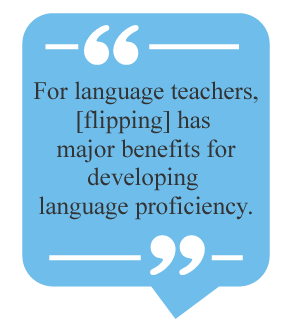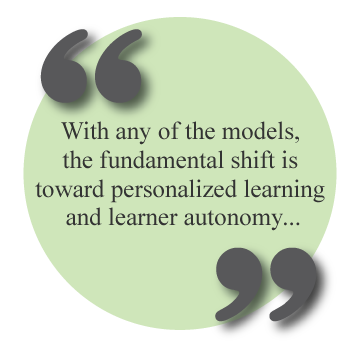6 Models of Flipped Learning Instruction
by Helaine W. Marshall
 Flipped learning is an educational model in which students are presented with content at home, most commonly on video, and work on applying what they have learned to in-class activities, transforming the classroom into a “dynamic, interactive learning environment where the educator guides the students as they apply concepts and engage creatively in the subject matter” (Flipped Learning Network, 2014). For language teachers, moving the direct instruction to the out-of-class context and the assignments to the in-class context has major benefits for developing language proficiency (Marshall, 2014). Over the past 5 years, flipped learning has found a strong voice within the field of TESOL, as evidenced by numerous conference presentations and publications noting its implementation (e.g., Bauer-Ramazani, Graney, Marshall, & Sabieh, 2016; Brinks Lockwood, 2014; Kostka & Marshall, 2017).
Flipped learning is an educational model in which students are presented with content at home, most commonly on video, and work on applying what they have learned to in-class activities, transforming the classroom into a “dynamic, interactive learning environment where the educator guides the students as they apply concepts and engage creatively in the subject matter” (Flipped Learning Network, 2014). For language teachers, moving the direct instruction to the out-of-class context and the assignments to the in-class context has major benefits for developing language proficiency (Marshall, 2014). Over the past 5 years, flipped learning has found a strong voice within the field of TESOL, as evidenced by numerous conference presentations and publications noting its implementation (e.g., Bauer-Ramazani, Graney, Marshall, & Sabieh, 2016; Brinks Lockwood, 2014; Kostka & Marshall, 2017).
With the rapid development of flipped learning, there have emerged a number of models, all of which adhere to its principles but apply them according to the exigencies of a particular instructional context. As the approach becomes more common in the TESOL field, educators need to determine which models best suit their program. While flipping does not necessarily mean students will be viewing video lessons (Brinks-Lockwood, 2014), the six models described here all stipulate engagement with video. Sams, in 2018, advocated that flipped learning return to its roots and affirm the primacy of video, and, for many language learners, the enhancements video provides mean greater accessibility (Walsh, 2018).
Flipped Learning: 6 Models
For each of the models included here, along with the originator and a basic description, there is a connection to TESOL methodology and a rationale for its use in language instruction.
 1. Flipped Mastery
1. Flipped Mastery
This model, associated first with Bergmann and Sams (2012), hearkens back to the days of individualized instruction in language teaching, but in the flipped learning context, it means that students will view material at their appropriate level and move at their own pace with the instructor guiding them. It is basically mastery learning made possible through flipped learning. As it is flipped, the lessons are viewed out of class and the practice and application is done in class. The instructor is very busy in this model as the students progress, arranging groupings, working with individuals, and doing informal assessments.
Most Effective Contexts: It could be useful in pronunciation work when students focus on different issues, so it’s not just linear but can also be differentiated. It works well for courses in grammar and discrete skills, or TOEFL prep, where students spread out in their levels and pacing.
2. Explore-FLIP-Apply
This model, proposed by Musallam (2013), echoes Freire’s problem-posing approach to language education. It is useful in developing motivation and relevance; the students have a reason to dig into the out-of-class work. In this model, students begin by examining a problem in class and then the instructor provides missing pieces they need for out-of-class work. Then, when they return to class, students and teacher work together on the problem armed with new knowledge.
Most Effective Contexts: This is effective in adult education classes where English is often being learned to facilitate negotiating life’s tasks or in English for specific purposes or English for business.
3. In-Class Flip
This model was originally proposed by Gonzalez (2014), and in the TESOL field it is associated with Carolina Rodriguez Buitrago and Martha Ramirez. As the name implies, the content is viewed in class. The advantage is that students may not have access at home. Also, it enables the instructor to make adjustments to the content on the spot. There are several ways to implement the model. For example, there can be a rotation approach using stations—one for viewing, one for group activities, and another for the instructor to work directly with a group. There are other configurations, such as partner viewing or group work. It is also great for jigsaw activities in content-based classes, where each group is assigned a different set of materials.
Most Effective Contexts: This model works well for younger learners who may need more guidance and structure or simply to acclimate all students being exposed to flipped learning for the first time.
4. Peer Instruction
This model originated with Mazur (see Berrett, 2012) and is now associated with Julie Schell, who was mentored by him at Harvard. For TESOL, this model takes on the look of the turn and talk activity, with a twist. The idea is to have students respond to online polls based on the out-of-class work, and then if results show lack of consensus, they work with each other to help clear up misconceptions. Students retake the poll and then the instructor adds any additional clarification. Another use for this concept is to have students make mini-lessons for the class with questions, to teach their fellow students.
Most Effective Contexts: This works well in large classes that used to be lecture classes where students had little opportunity to practice the language. For those teaching in an EFL setting that is set up for delivery of content and note-taking, this is a good way to flip because it builds in interaction.
 5. Online Flipping
5. Online Flipping
This model is not associated with anyone in particular, but Honeycutt (2014) discusses it in her flipped learning blog. The principle is that flipping is independent of the mode of instructional delivery. The instructor and students do not have to meet students face-to-face to use a flipped approach. Video lessons can be posted in an e-learning platform, and then students can engage in wikis, blogs, and forums online to share their understanding of the materials. The video lessons are created using tools, such as EDpuzzle or PlayPosit, where questions can be embedded, so the instructor can see what the students are mastering and plan the online activities accordingly. This way, the students feel they are having a real class, so to speak, through the recorded lessons. Moreover, the individual data is downloaded and analyzed in advance of class to inform instruction.
Most Effective Contexts: This model works when teaching online in an asynchronous format. This model relies on students being self-motivated and organized, so it is mostly for college and adult level learners.
6. SOFLA (Synchronous Online Flipped Learning Approach)
The last model is my own. I have also worked with Carolina Rodriguez-Buitrago in refining the model. SOFLA takes the online flip and adds to it synchronous classes that mirror in-person classes. The hallmark of this model is video conferencing in Adobe Connect, Zoom, or other spaces where students and instructor interact with audio and webcams in real time. Students can do group work in breakout rooms and report back to the main meeting room.
Most Effective Contexts: SOFLA works well in contexts where students can schedule specific times to have classes and are not attending a full-time program in a face-to-face setting, such as in college courses or adult education courses.
Flipped Learning Resources
Following is a list of resources for the six models of flipped learning discussed here; most are free to access, but several require subscriptions. Instructors will find that, over time and as circumstances change, they will turn to more than one of these. With any of the models, the fundamental shift is toward personalized learning and learner autonomy and away from the teacher-fronted language classroom. For instructors already moving in that direction, flipped learning will accelerate and facilitate their journey.
1. Flipped Mastery: “Flipping for Mastery” (article; Bergmann & Sams, 2014)
2. Explore-Flip Apply: Explore-Flip-Apply Example (blog; Musallam, 2011)
3. Peer Instruction: “How ‘Flipping’ the Classroom Can Improve the Traditional Lecture” (article; Berrett, 2012)
4. In-Class Flip: Modifying the Flipped Classroom: The “In-Class” Version (blog; Gonzalez, 2014).
5. Online Flip: Can You Flip an Online Class? (blog; Honeycutt, 2014)
6. SOFLA: “The Synchronous Online Flipped Learning Approach” (article; Marshall & Rodriguez-Buitrago; 2017)
Organizations Devoted to Flipped Learning
Upcoming Flipped Learning Professional Development
- Flipped Learning Conference @UNC, 11–12 June, Greeley, Colorado, USA
- FlipTech New England, 28–29 June, Waltham, Massachusetts, USA
- FlipTech Latin America, 27–28 September, Bogotá, Colombia
- RESCON ANZ, 18–19 October, Brisbane, Australia
References
Bauer-Ramazani, C., Graney, J. M., Marshall, H. W., & Sabieh, C. (2016). Flipped learning in TESOL: Definitions, approaches, and implementation. TESOL Journal, 7, 429–437.
Bergmann, J., & Sams, A. (2012). Flip your classroom: Reach every student in every class every day. Alexandria, VA: ASCD.
Bergmann, J., & Sams, A. (2014). Flipping for mastery. Educational Leadership, 71(4), 24–29.
Berrett, D. (2012). How ‘flipping’ the classroom can improve the traditional lecture. The Education Digest, 78(1), 36–41.
Brinks Lockwood, R. (2014). Flip it! Strategies for the ESL classroom. Ann Arbor, MI: University of Michigan Press.
Flipped Learning Network. (2014). Definition of flipped learning. Retrieved from https://flippedlearning.org/definition-of-flipped-learning/
Gonzalez, J. (2014). Modifying the flipped classroom: The “in-class” version [Blog post]. Retrieved from https://www.edutopia.org/blog/flipped-classroom-in-class-version-jennifer-gonzalez
Honeycutt, B. (2014). Can you flip an online class? [Blog post]. Retrieved from https://www.facultyfocus.com/articles/blended-flipped-learning/can-flip-online-class/
Kostka, I., & Marshall, H. W. (2017). Flipped learning in TESOL: Present, past and future. In J. Perren, K. Kelch, J. Byun, S. Cervantes, & S. Safavi (Eds.), Applications of CALL theory in ESL and EFL environments. Hershey, PA: IGI Global.
Marshall, H.W. (2014). Three reasons to flip your ESL classroom. Retrieved from http://newsmanager.commpartners.com/tesolc/issues/2014-02-01/2.html
Marshall, H. W., & Rodriguez-Buitrago, C. (2017, March). The synchronous online flipped learning approach. TEIS News. Retrieved from http://newsmanager.commpartners.com/tesolteis/issues/2017-03-15/6.html
Musallam, R. (2011). Explore-flip-apply example [Blog post]. Retrieved from http://www.cyclesoflearning.com/home/explore-flip-apply-example
Walsh, K. (2018, September 3). Flipped Learning TODAY interviews “The Accidental Guru”, flipped class pioneer Aaron Sams. Flipped Learning Today, 5. Retrieved from https://flt.flippedlearning.org/flipped-educator-interviews/aaron-sams/
Helaine W. Marshall is professor of education at Long Island University-Hudson, where she teaches courses in TESOL, linguistics, and multicultural education. Her research interests include culturally responsive teaching, instructional technology, and nontraditional approaches to grammar teaching. She has published in the TESOL Journal and Urban Review, among others. Most recently, she completed 5 years on the Board of the Flipped Learning Network and was the first editor of their newsletter, Flipped Learning Today.